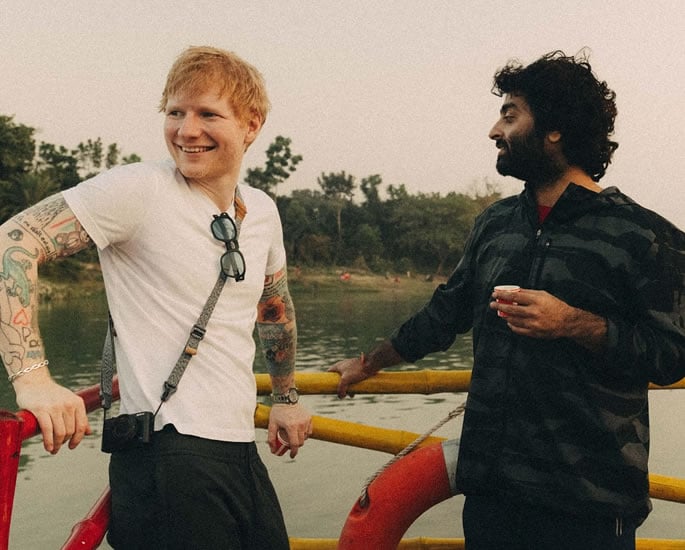“It’s something that’s been forming slowly."
Global music has a new pulse and it’s beating to South Asian rhythm.
From Lahore to London, these sounds are taking centre stage, challenging boundaries and proving that the culture isn’t confined by geography.
When Arooj Aftab became the first Pakistani artist to win a Grammy in 2022 for her ethereal ‘Mohabbat’, she signalled a shift.
A year later, Diljit Dosanjh turned Coachella into a celebration of Punjabi pride, bringing the language, the energy and the sound to one of music’s biggest global stages.
Now, artists like Avara are redefining what South Asian identity sounds like in the digital age.
Her music sits comfortably between meditative R&B and classical Indian vocal lines, resonating with millions online.
These aren’t isolated moments. South Asian sounds are connecting audiences from Mumbai to Manhattan, carried by a generation of artists who move freely between cultures and genres.
The world is finally catching up to a sound that has been evolving for decades.
Fusion & Familarity

The rise of South Asian-influenced music didn’t happen overnight.
It’s the result of globalisation, streaming algorithms, and a diaspora determined to see their sound recognised on its own terms. Record labels are paying attention.
In April, Warner Music Group launched 5 Junction Records, a label focused on introducing South Asian-inspired artists to North American audiences.
Billboard CEO Mike Van said: “It’s something that’s been forming slowly.
“We started to see these growth spurts over the last couple of years because of all the technology, evolving tastes and activation of these diaspora audiences.”
5 Junction’s general manager, Jürgen Grebner, said the label targets artists with dedicated home audiences.
He said a No. 1 song in India “automatically will chart in the top 20 on Spotify’s global charts”.
The data backs him up.
Avara has seen her Spotify listeners jump by more than 250% since November 2024. Her steady rise mirrors the growing appetite for cross-cultural sound.
Collaboration has also become central to expansion, as Grebner continued:
“The only way really to win in those markets is to collaborate.”
It’s a model that mirrors how culture itself spreads – through exchange, curiosity and connection.
Across the globe, these collaborations are paying off.
Nora Fatehi’s ‘Snake‘ with Jason Derulo broke into the top 20 on Spotify charts in the UK and Canada. Her background reflects how fluid identity can become when talent and ambition meet opportunity.
Bridging Cultures

Nora Fatehi’s career captures the modern South Asian journey, constantly crossing borders while staying connected to home.
She told Associated Press: “The Indian audience is the reason why I am what I am today. So while I’m making myself into a global artist, I’m bringing them with me.”
Nora left Canada for India, learning Hindi and auditioning for every opportunity she could find.
Now, she’s an international name, performing for audiences who understand her blend of confidence and cultural pride.
These stories build on a longer history.
In the 1960s, sitar virtuoso Ravi Shankar introduced the West to Indian classical music, influencing artists like The Beatles and John Coltrane.
Decades later, the same cross-cultural curiosity is driving today’s wave of South Asian creativity.
Professor Francesca Cassio, chair of Hofstra University’s music department, explained that much of South Asia’s traditional music evolved as a form of spiritual expression.
Its transformation into modern global pop shows how adaptable and enduring it is.
As Mike Van noted: “Artists have a direct connection now to their fans.
“You’ve got clips now, literally edited down to 10 seconds or less, that are capturing people’s attention that can go viral.”
Gen Z and Gen Alpha, he added, are the ones driving this openness to global sounds.
The accessibility of social media means South Asian musicians can bypass gatekeepers and reach audiences directly.
A TikTok snippet, a YouTube session, or a remix can now introduce a raag or dhol beat to millions who might never have heard it otherwise.
Reclaiming Roots, Reimagining Sounds

Avara’s music speaks to the in-between spaces where many South Asian creatives find themselves, belonging to two cultures yet fully accepted by neither.
In Marietta, Georgia, she grew up feeling “never a part of the brown community but never completely a part of the American community”.
She added: “I was around a lot of white people and people that didn’t look like me and I rejected a lot of parts of myself.”
Her upcoming album, MARA, continues that exploration. It blends Indian vocal riffs with Spanish guitar, reggae rhythms and soulful Western melodies, which mirrors her life.
Avara continued: “I’m trying to create something completely different.
“I’m trying to create a new genre with this stuff that comes from those influences of what I learned as a kid.”
It’s a feeling familiar to many in the diaspora: the urge to create something that reflects every version of yourself.
For these artists, music becomes a bridge between languages, generations and continents.
From the UK’s underground Desi scene to the viral rise of independent Punjabi and Tamil artists in the US, the momentum is unstoppable.
These musicians are no longer waiting for the world’s approval; they’re defining it on their own terms.
The global rise of South Asian sounds isn’t just about representation; it’s proof of how culture moves when it’s driven by people, not industry.
From Arooj Aftab’s stillness to Diljit Dosanjh’s swagger and Avara’s experimentation, these artists are reshaping the rhythm of modern music.
What connects them is more than heritage. It’s a shared confidence, a refusal to simplify who they are to fit someone else’s genre.
As new generations take control of the narrative, the sound coming out of South Asia and its diaspora isn’t waiting for space; it’s claiming it.
Confident, borderless and alive, this is what the future of global music sounds like.






























































